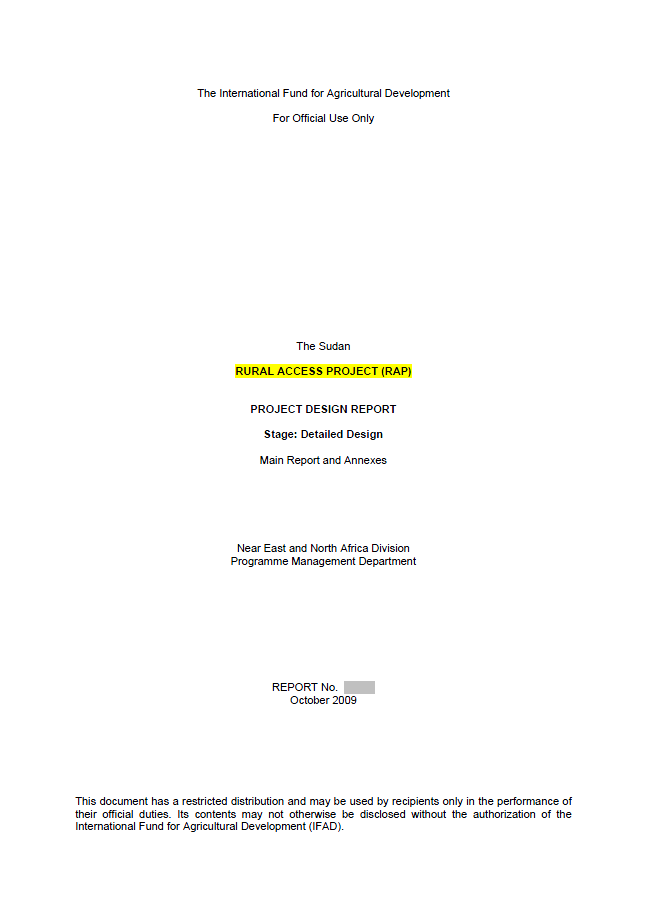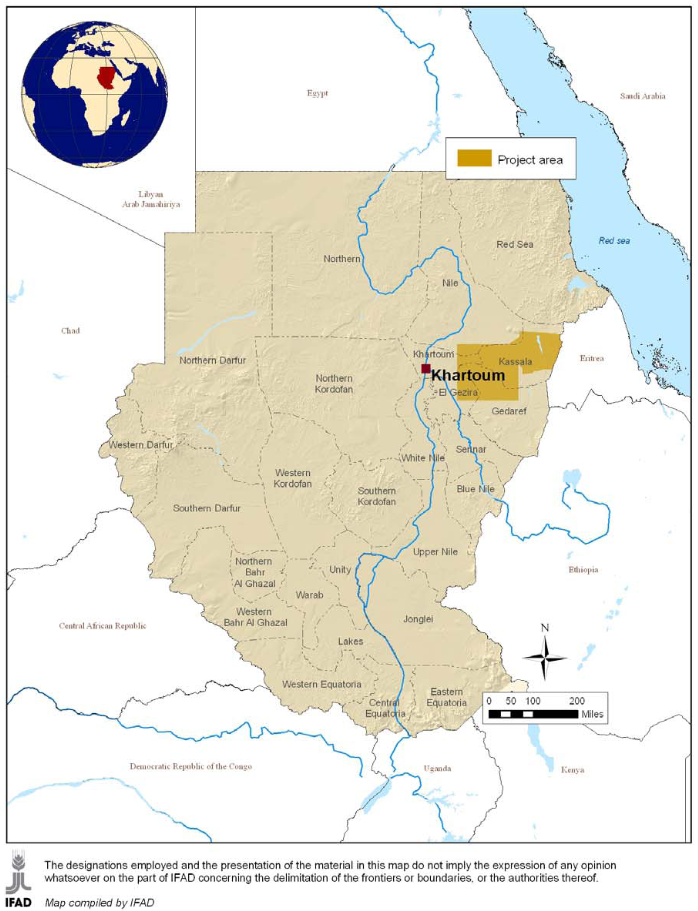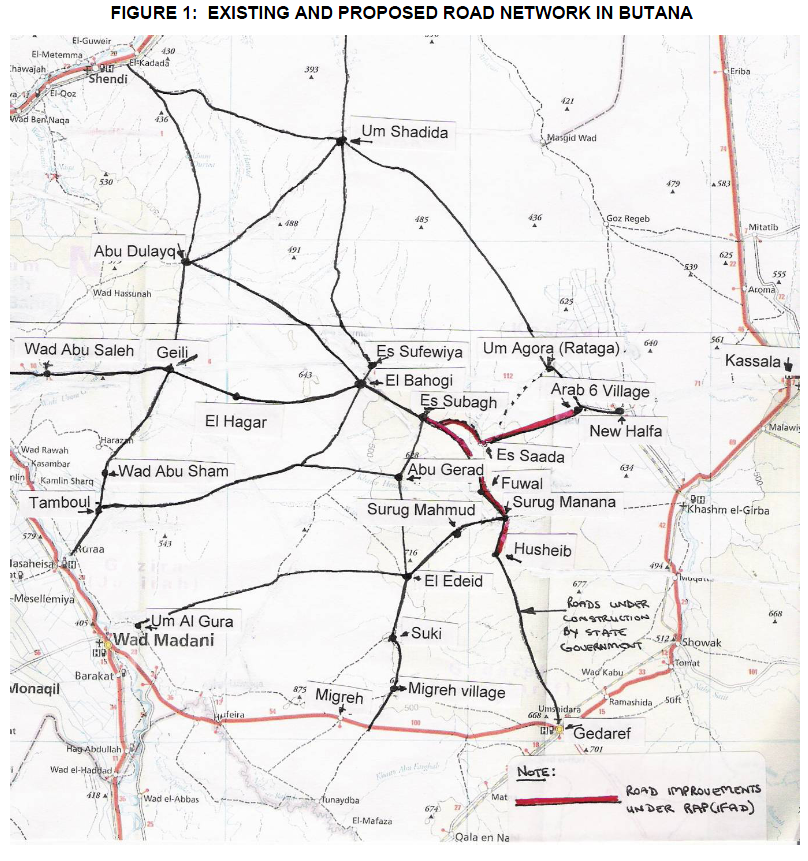 Near East and North Africa Division Programme Management Department
Near East and North Africa Division Programme Management Department
- 107 pages
- For Official Use Only
- October 2009
Executive Summary
Project rationale. The Rural Access Project invests in rural roads in a way that complements the transport, production and marketing infrastructure supported in the IFAD co-financed Butana Integrated Rural Development Project (BIRDP, SD-717) and the Government supported Agricultural Revival Programme (ARP). Its results will be measured on the cost and time of transport, the change in the farm gate price, and the savings in vehicle operating costs. These results are expected to enable small producers to take better advantage of the production and marketing activities proposed under the BIRDP and the ARP.
The approach adopted for the construction of rural roads will consist of spot improvements in the form of the establishment of wadi crossings, spot repairs and treatment of gulley erosion. The access road selected is the Arab 6 – Es Soubagh – Husheib alignment, a 144 km long road servicing 5 main markets, and covering 2 localities in 2 states (figure 1). The selection criteria included (i) synergy with on-going projects particularly the ARP and the BIRDP; (ii) clarity of the flow of benefits to small producers; (iii) responsive to community priorities; (iv) close fit with available grant resources.
Project area. The project area covers two localities (Butana in Gadaref State, River Atbara in Kassala State) (see figure 1). The area is characterized by silty clay and black cotton soils where relatively poor drainage characteristics combined with flat topography results in prolonged periods of inundation during the rainy season especially in depressions and flat plain areas. Throughout the rainy season, general access to and from the main external markets is very difficult for vehicular access, livestock and people especially across seasonal streams.
Project beneficiaries. The total number of beneficiaries is expected to be 130 000 persons equivalent to about 15 000 producer households. It is also expected that there will be 1700 additional women trading in the main markets serviced by the road. Poor households constitute 80% of the rural population in Butana.
Targeting and gender mainstreaming strategy. The localities selected are among the poorer in the Butana. The gender mainstreaming strategy relies on women participation in the consultation for the prioritization of rural roads, and in the implementation of the conservation and water control works protecting the rural roads, and for road maintenance. The RAP project area covers 21 communities located along the road alignment in the localities of Butana and River Atbara. These 21 communities represent a subset of the 140 communities planned to participate in the BIRDP.
Project objectives. The project will contribute to the COSOP 2009-2012 goal of empowering the rural poor to increase their food security, incomes and resilience to shocks. The main project objective is to improve the access of the rural population to markets and social services. Three key results are expected from the project:
– Rural roads upgraded in Central Butana and regularly maintained. The project target is 144 km.
– Communities are trained to manage road tolls and to engage in labor based maintenance contracts.;
– State capacity is strengthened to plan, design, supervise, and maintain rural feeder roads using the spot improvement approach.
Project activities. The project will have 3 main components:− Physical rehabilitation and construction of rural roads which consist in the improvement of the Arab 6 – Es Soubagh – Husheib road, implementing conservation works to protect the road from gulley erosion; and establishing the Community Road Fund which will act as the principal financing mechanism for the routine and periodic maintenance of the road.
− Capacity building and institutional development that would target the Road Departments of the State Ministries of Physical Planning and Public Utilities (MPPPUs) with formal and on-site training as well as office support; in addition to training of communities on soil and water conservation works to protect the road from gulley erosion and on the management of the labour based contracts for road maintenance. Road committees will be established to organize and implement the conservation and maintenance works.
− Project management. The Butana Development Agency (BDA) will be the lead agency for this project and will be responsible for the coordination and financial management of project activities. It constitutes a good platform for the coordination and implementation of inter-state initiatives that promote sustainable development of the Butana area. The BDA will maintain a close collaboration with the NHBA for the monitoring of the performance and progress of the road works, the comparative advantages of the spot improvement and preventative maintenance approach and its potential replication to the rural road network.
Integration within the country programme. RAP contributes directly to the achievement of the country programme strategic objective of increased access of the rural poor women and men to markets and to microfinance. The RAP specifically contributes to the following milestone indicator of approx 200 km of roads constructed in project areas; and to the outcome indicator of at least 20% producers’ access markets in the project area.
Project costs. The total project costs (including contingencies) are estimated at USD 14.96 million. The IFAD grant amounts to USD 12.95 million with a Government contribution of USD 1.92 million as duties and taxes and beneficiaries’ contribution of USD 0.09 million towards the maintenance of the road.Scaling-up potential. Scaling up is included as a result of the project. The project will develop the capacity of the road departments in the MPPPUs and will provide the cadre with the appropriate design manuals to train new staff and replicate the methodology of spot improvement to the rural road network in the 2 States of Gadaref and Kassala. Moreover, by involving the NHBA in the monitoring of the project, the potential for the replication of the spot improvement and preventative maintenance approach increases. The total set of road priorities identified is approx 1500 km in Butana. An amount of approx USD 12 million is required for the improvement of each 200 km road.
…


